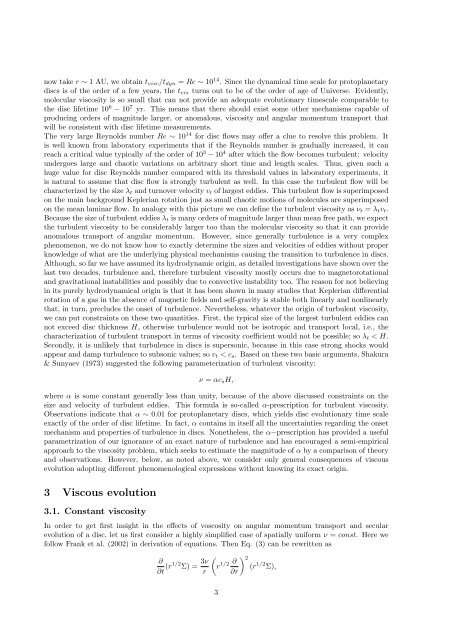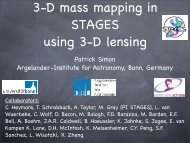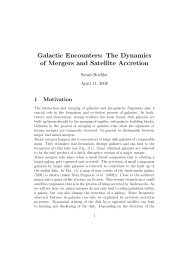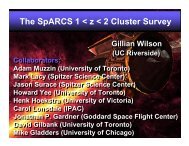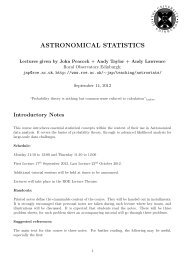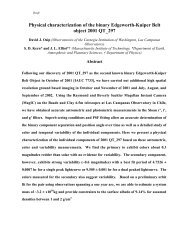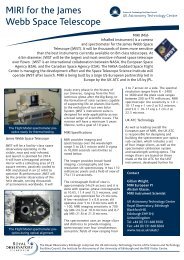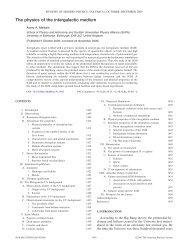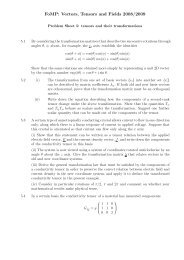Angular Momentum Transfer in Accretion Discs
Angular Momentum Transfer in Accretion Discs
Angular Momentum Transfer in Accretion Discs
You also want an ePaper? Increase the reach of your titles
YUMPU automatically turns print PDFs into web optimized ePapers that Google loves.
now take r ∼ 1 AU, we obta<strong>in</strong> t visc /t dyn = Re ∼ 10 14 . S<strong>in</strong>ce the dynamical time scale for protoplanetary<br />
discs is of the order of a few years, the t vis turns out to be of the order of age of Universe. Evidently,<br />
molecular viscosity is so small that can not provide an adequate evolutionary timescale comparable to<br />
the disc lifetime 10 6 − 10 7 yr. This means that there should exist some other mechanisms capable of<br />
produc<strong>in</strong>g orders of magnitude larger, or anomalous, viscosity and angular momentum transport that<br />
will be consistent with disc lifetime measurements.<br />
The very large Reynolds number Re ∼ 10 14 for disc flows may offer a clue to resolve this problem. It<br />
is well known from laboratory experiments that if the Reynolds number is gradually <strong>in</strong>creased, it can<br />
reach a critical value typically of the order of 10 3 − 10 4 after which the flow becomes turbulent: velocity<br />
undergoes large and chaotic variations on arbitrary short time and length scales. Thus, given such a<br />
huge value for disc Reynolds number compared with its threshold values <strong>in</strong> laboratory experiments, it<br />
is natural to assume that disc flow is strongly turbulent as well. In this case the turbulent flow will be<br />
characterized by the size λ t and turnover velocity v t of largest eddies. This turbulent flow is superimposed<br />
on the ma<strong>in</strong> background Keplerian rotation just as small chaotic motions of molecules are superimposed<br />
on the mean lam<strong>in</strong>ar flow. In analogy with this picture we can def<strong>in</strong>e the turbulent viscosity as ν t = λ t v t .<br />
Because the size of turbulent eddies λ t is many orders of magnitude larger than mean free path, we expect<br />
the turbulent viscosity to be considerably larger too than the molecular viscosity so that it can provide<br />
anomalous transport of angular momentum. However, s<strong>in</strong>ce generally turbulence is a very complex<br />
phenomenon, we do not know how to exactly determ<strong>in</strong>e the sizes and velocities of eddies without proper<br />
knowledge of what are the underly<strong>in</strong>g physical mechanisms caus<strong>in</strong>g the transition to turbulence <strong>in</strong> discs.<br />
Although, so far we have assumed its hydrodynamic orig<strong>in</strong>, as detailed <strong>in</strong>vestigations have shown over the<br />
last two decades, turbulence and, therefore turbulent viscosity mostly occurs due to magnetorotational<br />
and gravitational <strong>in</strong>stabilities and possibly due to convective <strong>in</strong>stability too. The reason for not believ<strong>in</strong>g<br />
<strong>in</strong> its purely hydrodynamical orig<strong>in</strong> is that it has been shown <strong>in</strong> many studies that Keplerian differential<br />
rotation of a gas <strong>in</strong> the absence of magnetic fields and self-gravity is stable both l<strong>in</strong>early and nonl<strong>in</strong>early<br />
that, <strong>in</strong> turn, precludes the onset of turbulence. Nevertheless, whatever the orig<strong>in</strong> of turbulent viscosity,<br />
we can put constra<strong>in</strong>ts on these two quantities. First, the typical size of the largest turbulent eddies can<br />
not exceed disc thickness H, otherwise turbulence would not be isotropic and transport local, i.e., the<br />
characterization of turbulent transport <strong>in</strong> terms of viscosity coefficient would not be possible; so λ t < H.<br />
Secondly, it is unlikely that turbulence <strong>in</strong> discs is supersonic, because <strong>in</strong> this case strong shocks would<br />
appear and damp turbulence to subsonic values; so v t < c s . Based on these two basic arguments, Shakura<br />
& Sunyaev (1973) suggested the follow<strong>in</strong>g parameterization of turbulent viscosity:<br />
ν = αc s H,<br />
where α is some constant generally less than unity, because of the above discussed constra<strong>in</strong>ts on the<br />
size and velocity of turbulent eddies. This formula is so-called α-prescription for turbulent viscosity.<br />
Observations <strong>in</strong>dicate that α ∼ 0.01 for protoplanetary discs, which yields disc evolutionary time scale<br />
exactly of the order of disc lifetime. In fact, α conta<strong>in</strong>s <strong>in</strong> itself all the uncerta<strong>in</strong>ties regard<strong>in</strong>g the onset<br />
mechanism and properties of turbulence <strong>in</strong> discs. Nonetheless, the α−prescription has provided a useful<br />
parametrization of our ignorance of an exact nature of turbulence and has encouraged a semi-empirical<br />
approach to the viscosity problem, which seeks to estimate the magnitude of α by a comparison of theory<br />
and observations. However, below, as noted above, we consider only general consequences of viscous<br />
evolution adopt<strong>in</strong>g different phenomenological expressions without know<strong>in</strong>g its exact orig<strong>in</strong>.<br />
3 Viscous evolution<br />
3.1. Constant viscosity<br />
In order to get first <strong>in</strong>sight <strong>in</strong> the effects of voscosity on angular momentum transport and secular<br />
evolution of a disc, let us first consider a highly simplified case of spatially uniform ν = const. Here we<br />
follow Frank et al. (2002) <strong>in</strong> derivation of equations. Then Eq. (3) can be rewritten as<br />
∂<br />
∂t (r1/2 Σ) = 3ν r<br />
(<br />
r 1/2 ∂ ∂r<br />
) 2<br />
(r 1/2 Σ),<br />
3


